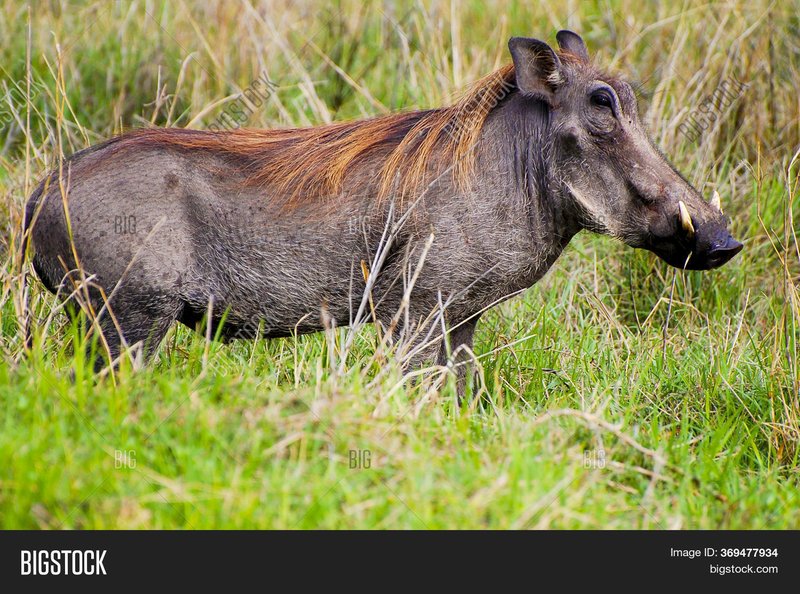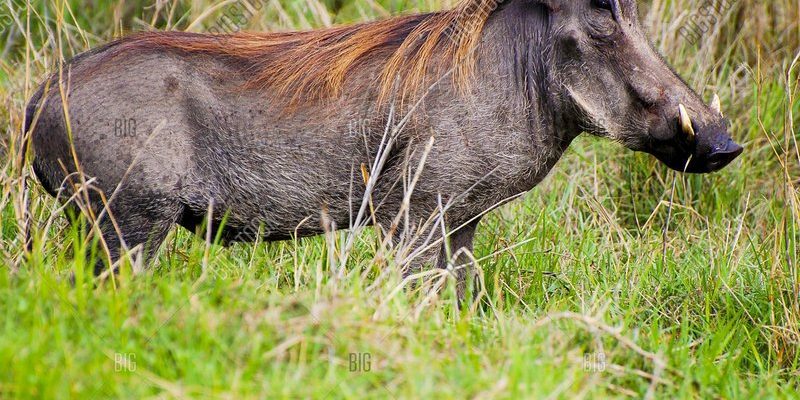
When you think of wild animals, you might picture lions prowling the savannah or elephants trumpeting across the plains. But another animal that deserves a spot in your mental gallery is the warthog. These fascinating creatures, with their distinctive appearance and quirky behavior, bring a unique charm to the African wilderness. Imagine a pig with tusks, a rugged mane, and a personality that ranges from shy to downright sassy. That’s what you get with a warthog!
The warthog, scientifically known as Phacochoerus africanus, is often seen foraging for food in the grasslands and savannahs of Africa. Unlike your backyard pig, warthogs are built for survival in the wild. Their tough hide and strong tusks help them navigate their environment and defend themselves from predators. It’s like they come equipped with built-in armor and a set of tools!
Physical Characteristics
Warthogs are unique in their appearance. One of the first things you’ll notice is their large heads, which are adorned with prominent tusks that can grow quite long. These tusks, which can be up to 25 inches in length, are actually used for digging and for defense against predators. You might think of them as the warthog’s own set of swords—essentially an impressive natural weaponry!
In terms of size, warthogs are medium-sized animals. They typically weigh between 110 and 250 pounds and stand about 30 inches tall at the shoulder. Their bodies are covered with coarse hair, often appearing dusty or scruffy, which helps them blend into their surroundings. This camouflage is crucial, especially when they’re trying to avoid larger predators, like lions or hyenas.
Interestingly, their skin is tough and can be quite resilient against harsh environmental conditions. However, it’s also sensitive. Warthogs often roll in the mud, which acts like a sunscreen and insect repellent. Can you picture that? A big, scruffy pig rolling in the mud to keep cool and stay safe—what a sight!
Habitat and Distribution
You can find warthogs primarily in sub-Saharan Africa, thriving in a variety of habitats. They prefer areas with open savannahs, grasslands, and woodlands where they can easily find food and have a clear view of approaching dangers. This is where their keen eyesight comes into play, allowing them to spot predators from a distance. If you ever watch a warthog, you might see them constantly peering around—it’s like they’re always on guard!
Warthogs are social animals, often living in small groups called sounders, typically consisting of females and their young. Males usually roam alone or form bachelor groups. They communicate with each other through a variety of sounds, from grunts to snorts, helping them stay connected in their sometimes dangerous habitat. It’s almost like they have their own secret language!
When it comes to survival, location is key. Warthogs will often dig their own burrows to sleep in, using their powerful tusks to create a cozy home. These burrows not only provide safety from predators but also help them avoid the midday sun. Think of it as their little escape from the harsh African heat!
Diet and Feeding Habits
Warthogs are primarily herbivores, which means their diet mainly consists of plants. They have a strong preference for grass, especially fresh shoots, but they’re not picky eaters. If grass is scarce, they will munch on roots, leaves, and even fruits. Imagine them wandering through the savannah, foraging for a delicious salad of sorts. Their dietary habits play a significant role in maintaining the ecosystem, as they help to keep the grasses managed and thriving.
One of the unique features of warthogs is their feeding style. They often eat on their knees, which may look a bit silly, but it’s actually quite efficient. This position allows them to reach the ground easily while also keeping their heads low to avoid being spotted by predators. It’s a clever survival tactic that speaks to their adaptability in the wild.
Warthogs are known to be opportunistic feeders, meaning they will take advantage of whatever food is available. During the dry season, their foraging skills really shine as they search for hidden roots and tubers. This adaptability is essential for their survival and allows them to thrive even in tough conditions.
Behavior and Social Structure
Warthogs are quite social animals and often live in groups, known as sounders, typically made up of females and their young. Males, especially those that are older, prefer to roam alone or gather in bachelor groups. Each sounder has a hierarchy, with the dominant female leading the way. It’s fascinating to think about how they establish these social structures, isn’t it?
In terms of behavior, warthogs are generally quite relaxed. They spend a good portion of their day grazing, but they also engage in some playful antics. Young warthogs love to play fight, chasing each other and rolling around in the dirt. It’s a bit like a game of tag, showcasing their energy and social bonds. You might even catch them relaxing and sunbathing, which is a sight to behold—imagine a scruffy little pig lounging in the sun!
However, when they sense danger, warthogs can be surprisingly quick! They are known for their ability to run at speeds of up to 30 miles per hour, using their agility to escape predators. When threatened, they may also take a defensive stance, showing off their tusks as a warning. It’s their way of saying, “Back off!”
Reproduction and Lifespan
Warthogs have a unique reproductive cycle. The mating season generally occurs in the rainy season when food is abundant. After a gestation period of about 5 to 6 months, females give birth to a litter of 2 to 8 piglets. It’s a joy to see these little ones scurrying around, exploring their new world! They are born with a fine layer of hair and are relatively helpless at birth, relying on their mothers for care and protection.
The young piglets grow quickly and begin to eat grass by the time they are just a few weeks old. They stay with their mother for about a year, learning crucial survival skills along the way. During this time, they develop social bonds and learn how to communicate with their peers. Isn’t it interesting how they adapt and grow in such a short time?
In the wild, warthogs can live up to 15 years, but their lifespan can be shorter due to predation and environmental threats. In captivity, they may live longer—sometimes reaching up to 20 years. This longevity highlights the importance of conservation efforts to protect these unique animals in their natural habitats.
Conservation Status
Warthogs are currently classified as Least Concern by the IUCN, meaning they are not at immediate risk of extinction. However, they face numerous threats that could impact their populations in the future. Habitat loss due to agriculture and human encroachment poses a significant challenge, as does poaching in some regions. It’s a stark reminder that even common animals can be vulnerable.
Fortunately, many conservation efforts are in place to protect warthogs and their habitats. Wildlife reserves and national parks provide safe environments for these animals to thrive. Conservationists are also working on educating local communities about the importance of preserving these unique species. Together, these efforts help maintain a balanced ecosystem where warthogs can continue to roam free.
Being aware of the challenges that warthogs face encourages us to appreciate and protect these remarkable creatures. After all, every effort counts when it comes to preserving the rich biodiversity of our planet.
Interesting Facts About Warthogs
| Common Name: | Warthog |
| Scientific Name: | Phacochoerus africanus |
| Habitat: | Sub-Saharan Africa, grasslands, savannahs |
| Diet: | Herbivore (grasses, roots, leaves) |
| Size: | Typically 110-250 lbs, about 30 inches tall at shoulder |
| Lifespan: | 15-20 years in captivity |
| Speed: | Up to 30 mph |
Warthogs are truly fascinating creatures that deserve our attention and respect. Their quirky looks, social nature, and resilience make them a wonderful part of the African ecosystem. Whether you’re learning about them for the first time or you’re a long-time fan, it’s clear that these wild pigs are much more than meets the eye. Their story highlights the beauty and complexity of nature—never forget how interconnected we all are!
FAQ
What do warthogs eat?
Warthogs are primarily herbivores, meaning their diet mainly consists of grass, roots, and leaves. They are opportunistic feeders, so they will adapt their diet based on what’s available, especially during dry seasons. Their strong jaws and teeth allow them to dig for tubers and other plants when food is scarce.
Where do warthogs live?
Warthogs are found throughout sub-Saharan Africa, thriving in a variety of habitats including grasslands, savannahs, and woodlands. They prefer areas that offer both food and protection from predators, often creating burrows to sleep in during the heat of the day.
Are warthogs social animals?
Yes, warthogs are very social creatures! They typically live in groups known as sounders, which usually consist of females and their young. Males may live alone or in bachelor groups. Their social structure helps them communicate and protect each other from dangers.
How fast can warthogs run?
Warthogs can run at speeds of up to 30 miles per hour. This agility helps them escape predators, and they often use quick turns and changes in direction to evade capture. It’s impressive how these seemingly clumsy animals can be so speedy when they need to be!
What threats do warthogs face?
While warthogs are currently classified as Least Concern, they still face threats such as habitat loss due to agriculture and urban development, as well as poaching. Conservation efforts are essential to ensuring their habitats remain intact for future generations.
Do warthogs have predators?
Yes, warthogs have several natural predators, including lions, hyenas, and leopards. Young warthogs are particularly vulnerable, so they rely on their mothers and the rest of their sounder for protection. Their quick reflexes and ability to run fast also play a crucial role in their survival.
Can warthogs swim?
Warthogs are not known for being strong swimmers, but they can wade through shallow water if necessary. They typically prefer to stay on land, especially since they are more adapted to terrestrial environments. However, if they need to cross a stream or river to escape danger, they can manage!
How do warthogs communicate?
Warthogs communicate with each other using a variety of sounds, including grunts, snorts, and even barking noises. These vocalizations help them stay in touch with each other while foraging or when they sense danger. They also rely on body language and social interactions to convey their feelings within the group.
Are warthogs endangered?
Warthogs are currently not considered endangered; they are classified as Least Concern by the IUCN. However, conservation efforts are still important to protect their habitats and ensure their populations remain stable. Ongoing threats like habitat loss and poaching could change their status if not addressed.
What is the lifespan of a warthog?
In the wild, warthogs typically live up to about 15 years, but in captivity, they can reach up to 20 years or more. This longevity is often influenced by their environment, predator presence, and availability of food and healthcare.
How do warthogs care for their young?
Warthogs exhibit strong maternal instincts. Females take care of their piglets, teaching them how to forage and stay safe from predators. Piglets stay with their mothers for about a year, developing crucial survival skills during this time.

